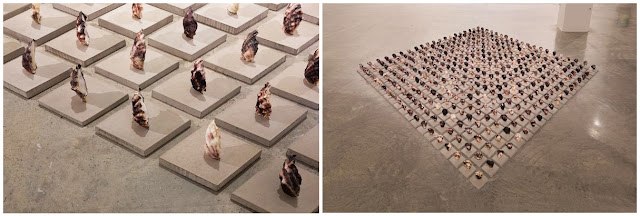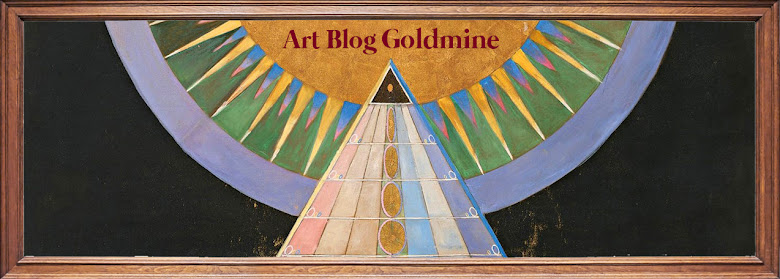Topics Covered
- Australia: Before Colonization, Violence, Settlement
- World: Individual, Population
Australia
Before Colonization
Comprised of two essential artworks, the image summarizes the theme of the exhibition. |
three close up paintings of Shirley Purdie, Goowoolem Gijam - Gija plants, 2013-16 |
 |
Megan Cope, Foundations III, 2020 |
Through the keen selection of the materials, the artist states that the purpose of destruction and mining was to lay out the basic foundation to establish the western system in the fertile land abundant in natural resources. The constant and calculated form of each component of the artwork graphically demonstrates the western system overridden onto the Australian landscape, connecting back to the artwork displayed on the wall.
Violence
 |
Tom Nicholson, Cartoons for Joseph Selleny, 2014 |
 |
Tom Nicholson, Cartoons for Joseph Selleny, 2014 |
1. a suite of large-scale charcoal drawings featuring soldiers shooting
2. a vast wall drawing: a myriad of tiny dots on an expansive paper
3. a takeaway artist's book
The component that addresses an evident narrative is 1. The subject relates to the story of the SMS Novara, an Austrian ship that docked in Sydney Cove in 1858 and departed with hundreds of handcrafts made by Aboriginal people destined for European collections. Joseph Selleny, as an official artist of the ship, produced numerous drawings of Australian flora, fauna, and even portraits of Aboriginal people. By depicting a graphic scene of violence, Nicholson points out Selleny omitted to depict colonial violence.
1, once had an apparent form, is smudged. The artist employed the cartoon technique to create the first two components of the artwork. The cartoon refers to the sketching technique for painting fresco (wall painting) invented by Renaissance artists. Once they finished sketching fresco subjects on a real scale with charcoal on paper, they punctured tiny holes in the outlines of the subjects. Then they pounced the paper with a small cushion against a wall to paint the fresco on. The process left dotted lines on the outlines of the subjects on the wall. 2 is the outcome of the repetition of the process, so the dots are in disarray.
When the intention of the cartoon and its process combined with the narrative of the artwork induces a wealth of connotations. Cartoon is a foundation for building up a fresco painting. Fresco is a large wall painting meant to be seen by mass, so publicity is one of the main characteristics of a fresco. By selecting shooting soldiers as a subject, the artist intended to publicize the violence of colonization that Selleny missed. Despite that he created a cartoon for his fresco, he didn't even start the base layer of the painting. Moreover, he repeatedly pounced the charcoal sketch to make the subject hard to identify. Through his process of cartooning, the artist compares shooting with pouncing, in which charcoal dots are 'shot' onto paper instead of bullets. In the artwork, the cartoon is a metaphor for colonial violence. Just as a sketch is ready for building up paint layers, colonial violence lays a foundation for building up a new governing system.
1, once had an apparent form, is smudged. The artist employed the cartoon technique to create the first two components of the artwork. The cartoon refers to the sketching technique for painting fresco (wall painting) invented by Renaissance artists. Once they finished sketching fresco subjects on a real scale with charcoal on paper, they punctured tiny holes in the outlines of the subjects. Then they pounced the paper with a small cushion against a wall to paint the fresco on. The process left dotted lines on the outlines of the subjects on the wall. 2 is the outcome of the repetition of the process, so the dots are in disarray.
When the intention of the cartoon and its process combined with the narrative of the artwork induces a wealth of connotations. Cartoon is a foundation for building up a fresco painting. Fresco is a large wall painting meant to be seen by mass, so publicity is one of the main characteristics of a fresco. By selecting shooting soldiers as a subject, the artist intended to publicize the violence of colonization that Selleny missed. Despite that he created a cartoon for his fresco, he didn't even start the base layer of the painting. Moreover, he repeatedly pounced the charcoal sketch to make the subject hard to identify. Through his process of cartooning, the artist compares shooting with pouncing, in which charcoal dots are 'shot' onto paper instead of bullets. In the artwork, the cartoon is a metaphor for colonial violence. Just as a sketch is ready for building up paint layers, colonial violence lays a foundation for building up a new governing system.
Settlement
 |
Rosemary Laing, brumby mound #6, 2003, Photography |
World
Individual
 |
Christian Thompson AO, Dead Tongue, 2015 |
The artist, who is of Bidjara descent, is aware that Bidjara is an endangered language, but he insists that it continues to be a living language if one word of the language is spoken. His work demonstrates the resilience of his Bidjara language and Aboriginal culture in the wake of Australia's colonization.
While showing Australian social issues, his image also reflects the conditions of non-westerners living in a modernized society. The traditional governing system of non-western countries was overridden by the western system directly or indirectly, as western ideas and systems established the foundation of modern society. Though traditional cultures are still tightly knitted to people's lives, the world is run by western ideas, especially capitalism, and productivity. Without any questions, modernized non-westerners follow the path set by past generations and instructions proposed by authority: they study at schools, then goes to work to afford their living.
Population
 |
Louisa Bufardeci, Ground Plan, 2003-2009 |
The most intriguing part about this work is that the size of each country is resized according to its population. The population is comprised of modernized westerners and non-westerners. The conditions of both groups of people are depicted by the previous artwork, Dead Tongue. Two artworks are purposefully displayed closely to communicate the idea of the world as a colony of modern civilization.
Thank you for finish reading the article. It is the first article of contemporary art chapter in the comprehensive study on Australian Art. The study is divided into three chapters according to era: classical, modern and contemporary. To view the complete list of the articles within the study, please direct to the linked article.
To support Art Blog Goldmine:
- Browse and read articles of similar topics in Art History: Contemporary
- Subscribe to the blog via RSS feed
- Follow Twitter for must-know art history facts and key art world news
- Recommend the blog to art enthusiast communities




No comments:
Post a Comment